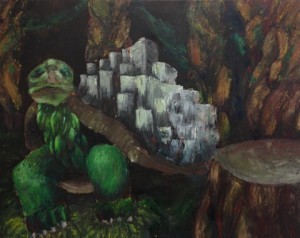While many students and artists alike may stray from conflict, one student at the University of Rhode Island uses it to enhance her work.
Senior art major Amanda Perry is a printmaker and a painter, and said that the the bulk of her work consists of combining the two mediums to create a more interesting whole. Through her work, she illustrates the age-old conflict of coexistence between humanity and nature and attempts to highlight the unity between the two. Some of her most recent prints “focus on nature and its interaction with man-made objects,†as well as how both nature and man struggle for control over the other.
“Nature isn’t always a bad thing; we don’t have to be afraid of it,†said Perry. “It might get in the way, but it’s still beautiful.â€
She described the relationship between humans and the natural world as both a conflict and a unity. Rather than attempting to convince the viewer of a certain opinion or to believe a certain interpretation of that conflict, she simply wants to present the idea to them and allow them to process and think about it. “It’s something that people may not think about a lot, but they might want to think about more,†Perry said.

As inspiration for her work, Perry says they she took to asking a simple question about common objects, like the truck and the fence: “What would happen if nobody used these for a long time?†Visually, she wanted to capture the change, “the fence deteriorating, the car growing mold, when nature takes over.â€
As far as her own feelings about that kind of change, she says, “I like it, but it is kind of scary … how nature will eventually take over. It’s so easy.â€
Interestingly, many of the dynamics that create Perry’s work also mirror the same kind of conflict-unity tension that the images in her art display. As an artist who combines both painting and printmaking, the two mediums intertwine and come together as different parts of a new whole, although they are quite different. The intersection of the painting and the print introduces new texture, both in the physical texture of the print and visually in the contrast between paint and carving, according to Perry, which she said “brings it to life more.â€
Perry’s use of color in her work also mirrors the unity and conflict in nature and man. “I use a lot of green and red; they complement each other, you see the colors and they work against each other and also with each other.â€
Perry has been an artist for her entire life. She said that her interest in art began in elementary school, increased in middle school and continued to grow throughout her time in high school. Despite this lifelong love of art, she had other plans at first.
“I initially decided not to study art, but I soon realized that art was the only thing I would want to do,†Perry said.
She added that her choice to switch back to being an art major three years ago was pretty obvious when she enjoyed an art history class she was in more than any of her other courses. Fortunately, Perry does plan to continue with art after she graduates this May.
“It’s kind of scary,†she said. “I’m prepared, but not prepared, you know?â€

